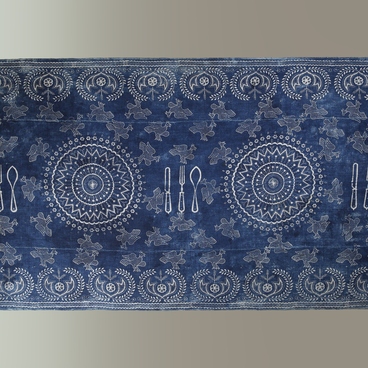Since ancient times, the belt has been an obligatory clothing accessory. Since the belt itself has always been perceived as the most powerful amulet and became an obligatory attribute in almost all rituals of the life cycle, it was natural to decorate it with various protective signs. Text and letter ornaments occupy a special place.
The Russian Museum has a large collection of peasant belts, with more than a dozen bright, colorful products made in the technique of weaving, which contained a text in its pattern. They were brought from expeditions to the Russian North and the Kalinin (modern day Tver) region. Such items had special names — “garusnye”, “zakladnye”, and “utochnye” — that were directly related to the technology of their production.
“Zakladnoye” weaving is a kind of hand-patterned weaving, which was most common in the southern regions. But only in the Russian North weavers made bright multi-colored “zakladnye” belts. The patterns were “drawn” with a contrasting thread (weft), which is laid only within the width of the pattern. The elements of the ornament, woven with multi-colored wefts, are separated from each other and from the base background by small through gaps obtained by turning the weft threads.
The northern worsted belts are distinguished by a clear, impeccable geometric design, outlined by the boundaries of one color. Letters of text are located on each segment of the stepped section of the pattern. The artisan used contrasting combinations: white letters on bright scarlet, orange on green, and other options. On all belts, the text is located in the middle part, and the ends are decorated with horizontal stripes in contrasting colors. Also, the belts are trimmed with tassels of multi-colored worsted wool. The dedicatory text “I give to whom I love” varies in completeness. This belt is distinguished from others by the presence of the number 1901 in the drawing and the arrangement of letters — in pairs against a contrasting background. Dates in the texts of the belts are a rare but very valuable phenomenon. Belts have been made and used for decades, and the presence of the date makes it possible to know exactly when the belt was created.
The Russian Museum has a large collection of peasant belts, with more than a dozen bright, colorful products made in the technique of weaving, which contained a text in its pattern. They were brought from expeditions to the Russian North and the Kalinin (modern day Tver) region. Such items had special names — “garusnye”, “zakladnye”, and “utochnye” — that were directly related to the technology of their production.
“Zakladnoye” weaving is a kind of hand-patterned weaving, which was most common in the southern regions. But only in the Russian North weavers made bright multi-colored “zakladnye” belts. The patterns were “drawn” with a contrasting thread (weft), which is laid only within the width of the pattern. The elements of the ornament, woven with multi-colored wefts, are separated from each other and from the base background by small through gaps obtained by turning the weft threads.
The northern worsted belts are distinguished by a clear, impeccable geometric design, outlined by the boundaries of one color. Letters of text are located on each segment of the stepped section of the pattern. The artisan used contrasting combinations: white letters on bright scarlet, orange on green, and other options. On all belts, the text is located in the middle part, and the ends are decorated with horizontal stripes in contrasting colors. Also, the belts are trimmed with tassels of multi-colored worsted wool. The dedicatory text “I give to whom I love” varies in completeness. This belt is distinguished from others by the presence of the number 1901 in the drawing and the arrangement of letters — in pairs against a contrasting background. Dates in the texts of the belts are a rare but very valuable phenomenon. Belts have been made and used for decades, and the presence of the date makes it possible to know exactly when the belt was created.



